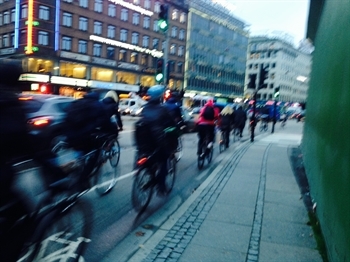I was recently in Europe with the German Marshall Fund's Marshall Memorial Fellowship, through which I visited Brussels, Copenhagen, Lisbon, Sarajevo and Paris. For 24 days, my chief job was to be intensely curious—and all that curiosity got me thinking about its power and importance in our lives.
Curiosity is one of our primary sources of meaning and purpose, says Todd Kashdan in his book Curious?. I’ve got to wonder, then, why there seems to be a dearth of curiosity in the world we inhabit. In Chicago where I live, I see this lack of curiosity in the separate, segregated lives that many of us lead. We stay in the spaces we already know, where we can safely anticipate what we will find, what people will look like and how they will behave. In our cities, I see this lack of curiosity in how we continue to do what we’ve always done since the rise of the automobile, and neglect to ask if we can learn from other places, if we could learn from what people are already telling us if we would just pay attention.
While traveling to five very different cities throughout Europe with the Marshall Memorial Fellowship, I’ve had the opportunity to reflect further on the concept of curiosity, and what it might mean for us if we cultivated more curiosity about the world and our lives.
Curious: Eager to know or learn something
What would it look like to be curious about the spaces we inhabit?
In the movie The Human Scale, Copenhagen-based architect Jan Gehl notes that we know more about the right environment for the gorilla than we do the homo sapien. Whole professions have been created to study and plan for cars: traffic engineers, highway planners, and car-counting technology, to name a few. But we haven’t been curious enough about ourselves.
While in Copenhagen, I was able to meet with Helle Soholt, co-founder of Gehl Architects, who detailed for me how over the years they have studied and documented how people use space in order to inform its design. She calls it “measuring life that takes place in between buildings.” They seek to answer questions such as, What kind of spaces most attract people? What ages and genders are most prevalent? How does sun and shade impact use? What drew people to this space? How does pedestrianizing a street impact people’s behavior? Attempting to answer these questions is a major commitment to curiosity; their work in New York City covered two different seasons and involved 80 to 90 people conducting observations. These are not one-time studies but instead a process they undergo for each geography to understand its unique characteristics, and plan for its new design accordingly.

Marisa Novara
Morning commute in Copenhagen
We already know that if you make more roads you will get more cars and more traffic. Gehl Architects’ curiosity and methods of paying attention have led them to understand something we didn’t necessarily know, something fundamental: If you create more space for people, you will have more people and more public life. These first observations back in the early 1960s led to the pedestrianization of Copenhagen’s major shopping street, Stroget, which in turn marked a major shift away from cars across the city; 60 percent of residents now commute by bike. In New York City, their work on the pedestrianization of Times Square led to a 65 percent decrease in injuries to pedestrians, and a 40 percent decrease in air pollution. This is the power of paying attention.
Curious: Inquisitive
What would it look like to be curious about people with whom I share space?

Community policing in Vollsmose
Outside of Odense, Denmark, we met with a police commissioner who oversees a housing development with a large percentage of immigrants and refugees. Faced with both actual crime and misperceptions from the broader community that it’s worse than it is (“it’s only a combat zone to journalists”), the Commissioner has employed a revolutionary tool: curiosity. Having partnered with a Muslim woman on an effort called Project Dialogue, they explained that they train officers to get to know the population of the housing development, to learn about their holidays, religion and culture. This is step one in building trust and establishing dialogue. In their words, “we encourage officers to be curious…when you don’t know people, it’s easy to be scared of them.”
I’ve found myself wondering what it would look like if more Chicagoans saw their city, its people and its neighborhoods with this lens of curiosity, rather than one of fear of the unknown, or disinterest in the unfamiliar. It seems that, instead, we gravitate toward certainty. As one of my fellowship colleagues noted, the bigger your world gets, the smaller you realize you are.
Kashdan tells us that curiosity is also about how we pay attention; what if instead of doing what we’ve always done, we paid attention to how people actually want to move through and inhabit the city’s spaces? It takes time, and for a society geared toward action, this can be anathema. But the results of time dedicated to curiosity creates places and relationships that cultivate meaning and emotional connection, and as author Peter Kageyama notes in his book, For the Love of Cities, people who love their cities fight for them. He notes that “when we love our city, as when we love another person, we will go to extraordinary lengths for them…when we have an emotional connection to our place, we are less likely to leave it and far more likely to champion and defend it in the face of criticism. We will fight for it.”
Why not put our energy, time and money into creating places that people love, defend and never want to leave?
Take a look at Marisa's photo essay of her time in Lisbon's Mouraria neighborhood.
This post also appears on the German Marshall Fund of the United States' GMF Blog.